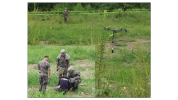Search
Using the filters to the left, click your selection, it will become bold and filter the results, click it again to remove that filter.
The Strategy of Terrorism – How it Works and Why it Fails Written by: Peter R Neumann and Michael LR Smith, Routledge, London, 2008, ISBN: 9780415545266, 140pp. Reviewed by: Major Jason Harley This book is a valuable contribution to military studies. Terrorism is a most misunderstood term in both society and academia, and for military practitioners equally so. While the book explores the strategic aspects of terrorism in first principles, it is written in a simple clear manner. It unearths a number of …

‘Sorry, lads, but the order is to go’ – The August Offensive, Gallipoli: 1915 Written by: David W Cameron, UNSW Press, Sydney, 2009, ISBN: 9781742230771, 370pp. Reviewed by: Rhys Crawley After the months of stalemate that followed the failed Gallipoli landings, the Allied high command began to look for new options. They decided to mount a breakout manoeuvre from the Anzac sector to seize the northern heights and eventually cross the peninsula. At the same time there was a new landing at Suvla Bay which …

Abstract Army’s doctrine is absolutely certain of the importance of close combat. Land Warfare Doctrine 1 (LWD–1) in fact describes close combat as Army’s fundamental skill—is this true? Is the doctrinal focus of close combat reflected in the training areas and schools of the Army? The anecdotal evidence is that it is not. An examination of recent works on distributed manoeuvre identifies the essential characteristics of any close combat training ‘system’. Training close combat is at the forefront of …
Abstract The complexity of modern warfare makes decision difficult to achieve. Conventional wisdom holds that, when fighting insurgents and other asymmetric actors, wars will be long and costly struggles that simply pit political wills against each other in a Clausewitzian kind of grey clash of ... moral masses’. In this article, the authors reject this fatalist view and posit that, with the right skill sets, Western commanders may possibly be able to restore their ability to achieve decision on the modern …
Abstract The article gathers together a collection of thoughts on command from the perspective of a brigade commander. Most will not be new. They are aimed at commanding officers, though some will resonate with more junior commanders. The article has been derived from a speech delivered at the 2008 and 2009 pre-command courses in Canungra by the then Brigadier Stephen Day. I worked with ten different commanding officers while I was a brigade commander. They were the ablest of soldiers. We learnt much in …
Abstract In response to a recent essay in the Australian Army Journal, which continued the current debate about ‘Cultural Awareness’, this article examines the place of the Australian soldier in the community. 1 It questions whether it is counterproductive to remove the soldier from the very community that could teach him the valuable skills in human relations he needs on operations. The author draws examples from current recruiting and accommodation practices, pre-deployment training, recent operations …
Abstract This article examines the limitations of traditional strategic approaches to the resolution of contemporary conflicts. It proposes control as the unifying idea for military action. Everything in war is simple, but the simplest thing is difficult. The difficulties accumulate... – Clausewitz Isaiah Berlins famous essay The Hedgehog and the Fox 1 was an examination of the work of Leo Tolstoy that rested on an observation from the ancient Greek poet Archilocus that ‘the fox knows many things but …
Abstract The purpose of this article is to highlight five challenges for Future Infantry in order to stimulate thinking about Future Infantry’s requirement to adapt and change. While this paper is Infantry focused, the challenges outlined will resonate with many people in the wider Army, and are of likely interest to people from Joint, whole-of-government, coalition, contractor and non-government organisations who expect to operate with Army in the future. In the twenty-first century, Future …
Abstract An enduring element of Australia’s commitment to Afghanistan is the Special Operations Task Group (known as TF66). This force is specifically trained for counter-terrorism and counterinsurgency operations, both of which have been conducted as part of the effort in Afghanistan. The effectiveness of these operations has to date been significant. This has been due to the direct and indirect Tines of Operation, which have been developed into a series of operating methodologies throughout the rotations …
QNG23 Challenge Outcomes This post continues a series on quantum technologies. It details outcomes and findings from the Army Quantum Next Generation Minesweeper Challenge 2023 . Landmines and buried ordinances pose a significant danger in warzones, extending through active conflict and lingering as a threat in the aftermath. Finding and clearing landmines is both a valuable military capability and a humanitarian tool. Existing methods of minefield clearance are slow and dangerous, relying on ground teams …

